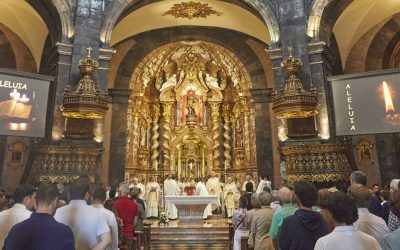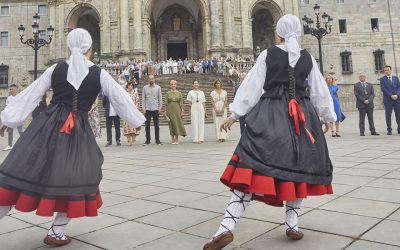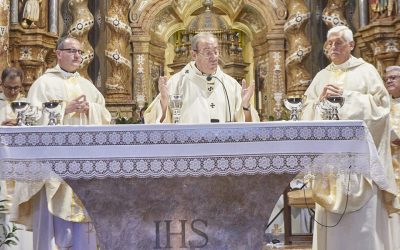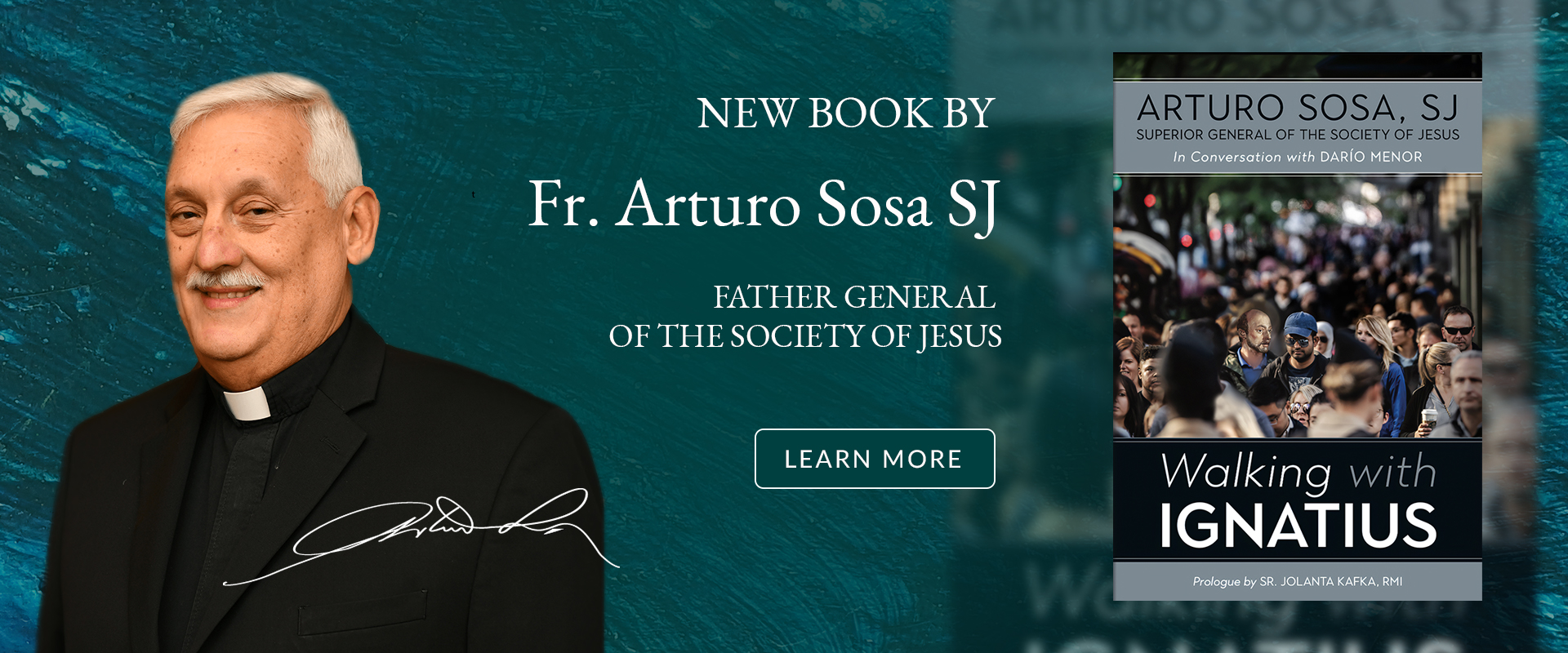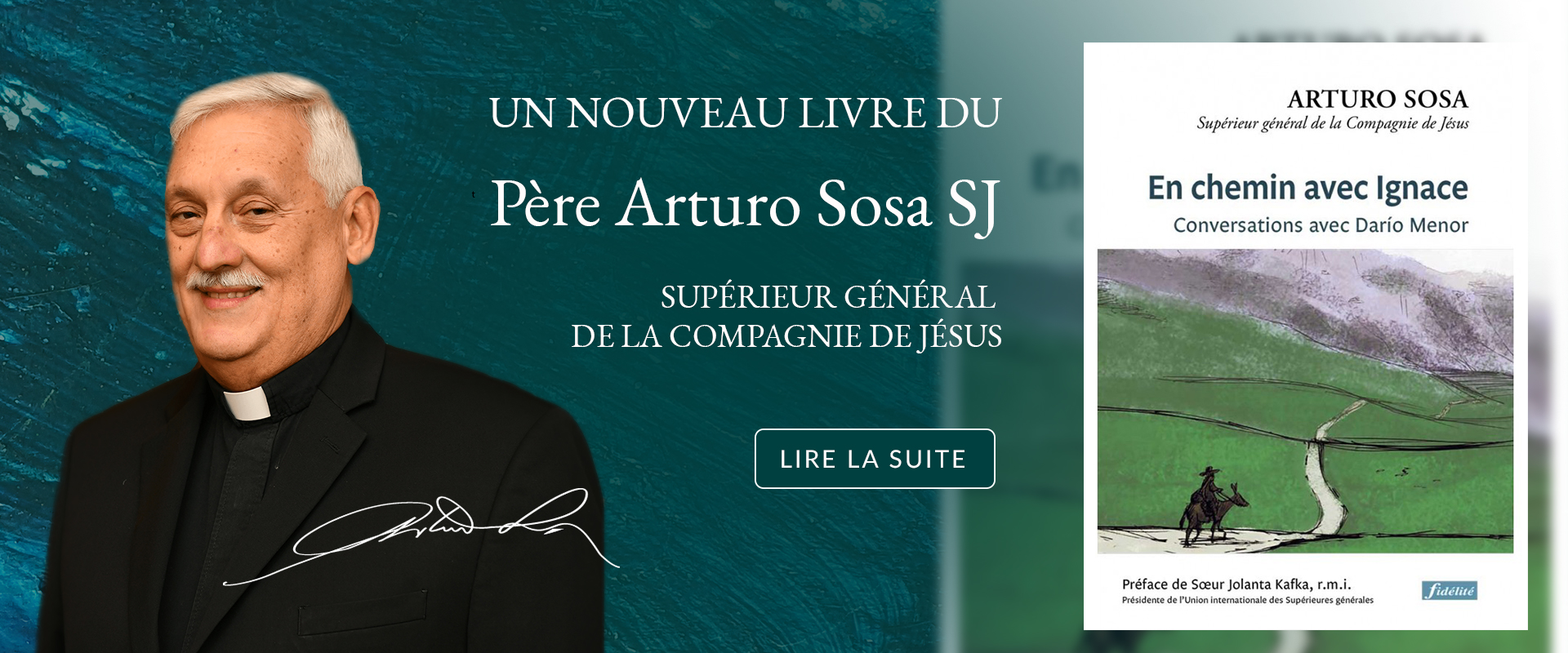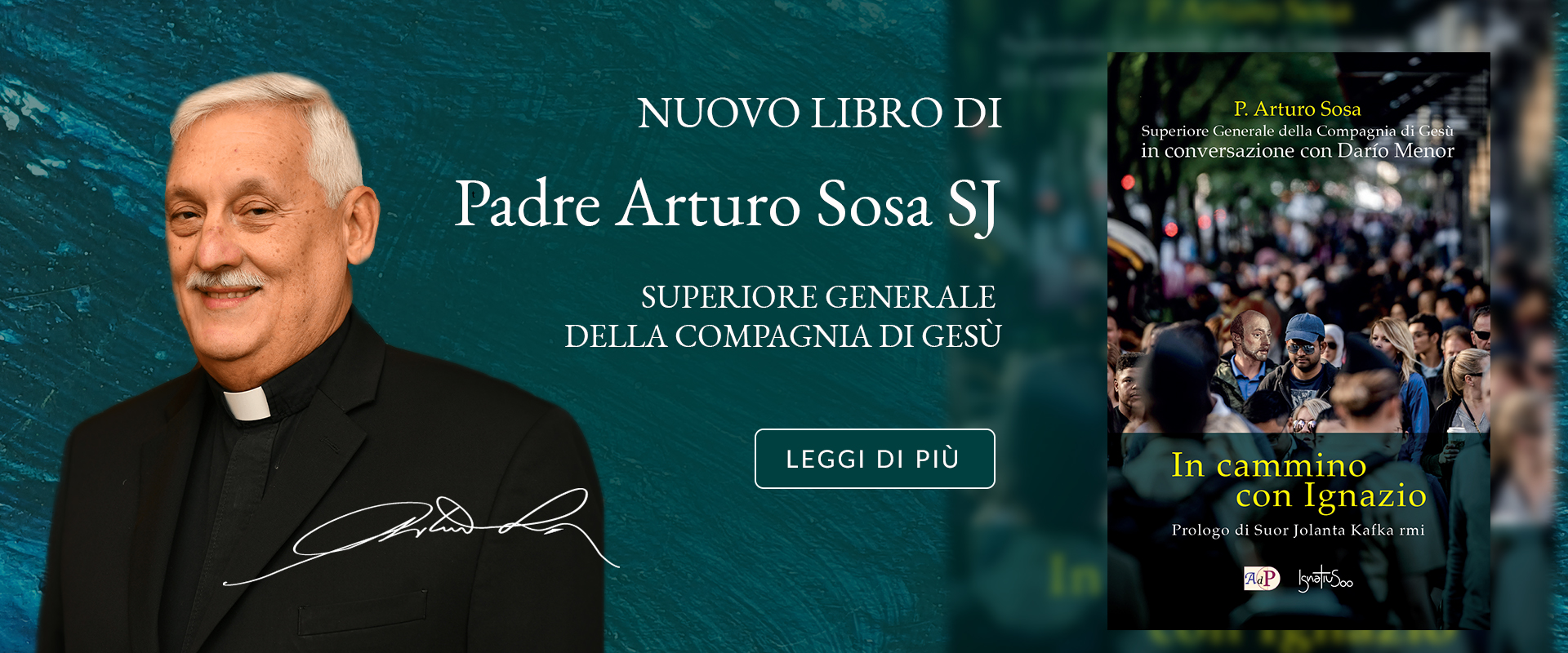Christmas with Ignatius of Loyola
During this Ignatian Year, let us reflect with Ignatius of Loyola on Christmas. This article was first published in Civiltà Cattolica (link).
Ignatius was convalescing in his castle in Loyola. A few months earlier, defending the walls of Pamplona during a French siege, a cannonball had broken his leg, and now he was slowly recovering. On long winter evenings he would normally read books on chivalry that excited his imagination. However, the only books in the castle were a Lives of the Saints and the Vita Christi (VC) by Ludolphus of Saxony. This esteemed ascetic writer (born around 1295, he died in Strasbourg in 1377) was first a Dominican, then a Carthusian, the prior of the Carthusian monastery of Koblenz, and author of the Vita Jesu Christi ex quatuor Evangeliis, a powerful theological-spiritual commentary on all four Gospels, enriched by many quotations from the Fathers and spiritual authors of the Middle Ages.[1]
A crucial reading
The year was 1521. Ignatius read those substantial volumes in a Castilian translation[2] and was attracted. He would say that this reading was crucial for his conversion.[3] Today, better than in the past, we realize the importance of the Vita Christi in Ignatius’ spirituality, to the point that we can find many traces of it in his Spiritual Exercises (ES),[4] especially in the contemplation of the Nativity (ES 111-117). For this reason, on the eve of the Ignatian Year 2021-2022, which the Jesuits intend to celebrate during the fifth centenary year of his being wounded at Pamplona.[5] We also want to reread with Ignatius the commentary Ludolphus made on Luke’s Gospel, chapter 2, which tells of the nativity of Christ. The learned Carthusian scholar follows the Gospel text to the letter, gradually introducing his comments. We will follow those that best serve our meditation on the mystery of Christmas.
The census
Luke 2:1: “In those days a decree went out from Emperor Augustus that all the world should be registered.”
Ludolphus emphasizes that at the time of Christ’s birth, “the world, previously perturbed, was quiet under the reign of Caesar Augustus. Christ wanted to be born at that time, because it was appropriate that, being born the peaceful king and the prince of peace, his birth was foretold by peace. Christ always sought peace. He loved lovers of peace and charity, and taught peace in his life and gave it as an inheritance to his disciples on his departure” (VC I, 9:1). According to Ludolphus, the census was not only a means of counting the inhabitants, but also a way of levying tribute. Thus, with three acts – self-certification, inscription and tribute – the Jews had to profess themselves subjects of the Roman Empire: “Here for the first time Judea became tributary of the Romans, forced to pay for its troops” (VC I, 9:2).[6]
Luke 2:4-5: “Joseph also went from the town of Nazareth in Galilee to Judea, to the city of David called Bethlehem, because he was descended from the house and family of David. He went to be registered with Mary, to whom he was engaged and who was expecting a child.”
Ludolphus comments: “For your sake the Lord chose to be enrolled in an earthly census, so that your name would be inscribed in heaven. Thus he gave you an example of perfect humility. The Savior began with it in his birth, and with it he continued until death, in which he ‘humbled himself, and became obedient to death, even death on a cross’” (Phil 2:8).[7] Ludolphus is also attentive to the condition of Mary, who was pregnant: “For from Nazareth to Jerusalem it is about thirty-five miles, and then, heading south from Jerusalem, after about five miles is Bethlehem.[8] And the Virgin, although she was close to giving birth, was not weighed down by the journey, but touched the earth lightly: the light she carried in her could not weigh her down” (VC I, 9:4).
Poor among the poor
Luke 2:6-7: “While they were there, the time came for her to deliver her child. And she gave birth to her firstborn son and wrapped him in bands of cloth, and laid him in a manger, because there was no place for them in the inn.”
Ludolphus remarks: “Because they were poor, they could find no housing, due to the great confluence of people there for the same reason. Put yourself in Our Lady’s shoes. See that delicate fifteen-year-old girl, tired from the long journey, who moves among people with modesty, looking for a place to rest and not finding one” (VC I, 9:6). In the end, Mary and Joseph find shelter in a temporary shelter, “inside the city, near one of the gates, under a concave rock that had no roof. The men who came to the city for a few stores used to bring their animals there” (ibid.).
Here Joseph begins to work: “He who was a carpenter made a manger for the ox and donkey they had brought with them: a donkey to put the pregnant Virgin on, and an ox, perhaps to sell and with the proceeds pay the tribute for himself and the Virgin, and have something to live on” (ibid.).[9]
The firstborn son
Ludolphus then explains in what sense it should be understood that Mary gave birth to “her firstborn son”: “Here firstborn does not say relationship to one who follows, but deprivation with respect to one who precedes him, because there was no one before him. Every only-begotten child, Bede says, is firstborn; and every firstborn, as such is only-begotten. And since the Son of God wanted to be born in time from a mother according to the flesh, in order to be able to acquire many brethren for the new birth in the Spirit, that is why it is better said firstborn than only-begotten” (VC I, 9, 7).
The birth took place “at midnight on the Lord’s day, when ‘night in its swift course was now half gone’ (Wis 18:14), because on the same day when he said: ‘Let there be light, and there was light’ (Gen 1:3), the Lord visited us, the ‘rising Sun coming from above’ (Luke 1:78)” (VC I, 9:7). “He was born at night, because he came in a hidden fashion, to bring back to the light of truth those who were in the night of error” (VC I, 9:8). As soon as he was born, “his mother immediately worshipped him as God, and by herself wrapped him in clothes, that is, in simple and used clothing, and placed him not in a cradle of gold, but in a manger, among the animals mentioned above, that is, the ox and the donkey” (VC I, 9:7).
Ludolphus comments: “You see the great poverty and destitution of Christ: not only did he not have a home of his own where to be born, but not even a place that could be considered convenient and adequate. It was necessary to put him in a manger for lack of space. Thus the saying was true: “Foxes have holes and birds of the air have nests, but the Son of Man has nowhere to lay his head” (Luke 9:58). Thus the Lord rested: first, in the Virgin’s womb; second, in a foul manger; third, on the gallows of the cross; fourth, in a tomb that was not his own. This was the extent of his poverty and his places of rest!” (VC I, 9:7).
Luke 2:8-9: “In that region there were shepherds living in the fields, keeping watch over their flock by night. Then an angel of the Lord stood before them, and the glory of the Lord shone around them.”
Why did the angel appear to the shepherds and not to others? Ludolphus responds: “First, because they were poor, and Christ came for the poor, as the psalm says: ‘For the misery of the poor and the groaning of the poor’ (Psalm 11:6). Second, because they were simple, as we read in Proverbs: ‘The simple are in his confidence’ (Prov 3:32). Third, because they were vigilant, as Proverbs says: ‘Those who seek me diligently, find me’ (Prov 8:17)” (VC I, 9:12).
Luke 2:10-11: “But the angel said to them, ‘Do not be afraid; for see, I am bringing you good news of great joy for all the people: to you is born this day in the city of David a Savior, who is Christ the Lord.”
Bethlehem, although a small village, was still the City of David, and significant events had taken place there. Ludolphus is pleased to enumerate them: “Bethlehem, a small town, minimal, opened the way to the homeland of paradise. Before, it was called Ephrath (cf. Gen 48:7). There was a famine there (cf. Ruth 1:1), after which there was a great abundance, and then it was called Bet-lehem, that is, ‘the house of bread.’ “It is by no means least among the cities of Judah” (Matt 2:6), being excellent in dignity, having known many significant events before the coming of Christ. David was anointed there (1 Sam 16:13), a solemn sacrifice was celebrated there (1 Sam 16:2), the marriage between Ruth and Boaz was celebrated there (Ruth 4). These three things foreshadowed the union of the divinity with humanity, the true sacrifice and the immutable kingdom. Then Bethlehem knew the joy of awaiting the coming of Christ. Who could worthily evaluate the joy of the angels who praised God, the shepherds who saw the Lord, the Magi who adored him and all the people who believed in him? But Bethlehem after the birth of Christ also knew the martyrs, when Herod had the children killed” (VC I, 9:22).
Ludolphus then explains the meaning of the term “Christ”: “Christòs in Greek is equivalent to unctus in Latin: in the Old Testament only kings and priests were ‘anointed’ [i.e. consecrated by sacred anointing]; now Christ is King and Priest, and therefore he is rightly called Christ, i.e. anointed, not by human anointing, but divine anointing, because in the humanity assumed for us he was anointed [i.e. consecrated] by God the Father, indeed by all the Trinity, with fullness of grace” (VC I, 9:12).
The sign of the Child
Luke 2:12: “This will be a sign for you: you will find a child wrapped in bands of cloth and lying in a manger.”
Ludolphus comments: “You will find, like one who is hidden, a child, like one who does not speak, and yet it is the Word of God; wrapped in swaddling clothes, not in silk garments, a sign of his poverty; lying in a manger, not in a cradle of gold, a sign of his humility, because even though he is the Lord of Lords he has lowered himself to be in a manger of animals. It should be noted that the shepherds were simple, poor and humble, i.e. people who can be despised; and in order for them not to be afraid to approach, they were given the signs of childhood, of poverty and humility in Christ. These are the signs of Christ’s first coming; others will be the signs of his second coming” (VC I, 9:12).
Luke 2:13-14: “And suddenly there was with the angel a multitude of the heavenly host, praising God and saying, ‘Glory to God in the highest heaven, and on earth peace among those whom he favors!’”
Ludolphus read in the Latin text: “Peace on earth to people of good will,” that is, “to those who welcome the new born Christ, with good will, without persecuting him. For ‘there is no peace for fools?’ (Isa 2:22), while there is ‘much peace for those who love your law, Lord’ (Psalm 118:165). In fact, according to Pope Leo, the true peace of the Christian consists in not separating himself from the will of God and in feeling joy only in the things of God. To be at peace with God is to want what he commands and not to want what he forbids. Peace is therefore proclaimed to people of good will, that is, to good people” (VC I, 9:14). “It is well said: Glory to God and peace to all people. For through Christ, the Father is glorified and peace is made between God and humans, between the angel and us, between the Jews and the other peoples” (ibid.).
Luke 2:15-16: “When the angels had left them and gone into heaven, the shepherds said to one another, ‘Let us go now to Bethlehem and see this thing that has taken place, which the Lord has made known to us.’ So they went with haste and found Mary and Joseph, and the child lying in the manger.”
‘Go yourself and see the Child’
Here Ludolphus invites each one of us to become one of the shepherds: “Go yourself now and see the Word made flesh for you and, kneeling, adore the Lord your God, greet his Mother and Saint Joseph with respect. Then kiss the feet of the child Jesus, lying in the manger, and pray to Our Lady to hand him to you or allow you to take the child. Then take him with you and hold him in your arms. Look carefully at his face, kiss him with respect and delight in the depths of your heart. You can do it, be sure, because he came precisely for sinners, to save them; he treated them with humility and in the end gave himself to them as food. The Lord, who is good, will patiently allow you to touch him, and will not consider it presumptuous, but an act of love. But always do it with reverence and fear, for he is the holy of holies. Then return him to his mother, and observe carefully how diligently and wisely she nurses him and treats him, and carries out the other tasks. Be ready to serve him and help her if you can” (VC I, 9:20).
Here we cannot fail to mention Ignatius of Loyola, who in his Spiritual Exercises wrote: “See Our Lady and Joseph and the handmaiden and child Jesus, after he is born, making myself the poor unworthy servant boy who looks at them, contemplates them and serves them in their needs as if I were present, with every possible respect and reverence” (ES 114).
In conclusion, Ludolphus takes up the accents of the Christmas liturgy: “You must therefore meditate with joy on how great the solemnity of this day is. For today Christ is born, and this is truly the Christmas day of the eternal King and the Son of the living God. Today ‘for us a child was born, the Son was given to us’ (Isaiah 9:6). Today the ‘sun of righteousness’ (Mal 4:2), previously hidden by clouds, has risen and shone with clarity. Today the ‘bridegroom’ of the Church, head of the elect, ‘has come out of his bridal chamber’ (Psalm 18:5). Today ‘the most beautiful among the sons of men’ (Psalm 44:3) has shown his desired face. Today the day of our redemption, of ancient reparation, of eternal happiness, has shone for us. Today peace is announced to us, as we sing in the angelic hymn. Today, as the Church sings, the heavens are dripping honey all over the world. Today ‘the kindness and humanity of our Savior our God has appeared’ (Tit 3:4)” (VC I, 9:26).
Colloquy
A characteristic of Ludolphus’ commentary is that each chapter ends with a prayer, in conversational style, whose content is suggested by the same Gospel text.[10] Here is the one at the end of the chapter on the Nativity: “Sweet Jesus, you who were born humble from a humble handmaiden, you who wished to be wrapped in humble clothes and laid in a manger, grant me, through your ineffable nativity, most merciful Lord, that the holiness of a new life may be reborn in me. Let me humbly wear the religious habit, so that, taking my rule of life seriously, as if I were lying in a manger, I may reach the summit of true humility. And as you, have deigned to participate in our humanity and mortality, let me be part of your divinity and eternity. Amen” (VC I, 9, oratio).
DOI: La Civiltà Cattolica, En. Ed. Vol. 5, no. 1 art. 1, 1020: 10.32009/22072446.0121.1
[1]. Ludulfus de Saxonia, Vita Jesu Christi ex Evangelio et approbatis ab Ecclesia Catholica doctoribus sedule collecta, Parisiis – Bruxellis, Societas Generalis Librariae Catholicae, 1878, voll. I-IV. It is quoted here in translation with the initials VC.
[2]. The translation was that of Franciscan Ambrosius Montesino (late fifteenth century). It was Queen Isabella who asked for that translation, making a gift of it to the members of the court. This is probably how those large volumes in folio ended up in the Loyola castle. According to experts, Montesino’s was a fairly faithful translation.
[3]. Cf. Ignatius of Loyola, Autobiography, Nos. 5-6: “And since he was very devoted to reading worldly and false books, so-called books on chivalry, feeling well, he asked them to give him some to pass the time; but in that house there was no book of those he used to read, and so they ended up giving him a Vita Christi and a book on the lives of the saints in the vernacular. Reading and rereading those books several times, he ended up getting attached for a while to what was written there” (Gli scritti di Ignazio di Loyola, Rome, AdP, 2007, 85f).
[4]. For more on Ludolphus and the influence of his Vita Christi on Ignatius, see E. del Río, Ludolphus de Sajonia, La vida de Cristo, I-II, Madrid, Universidad Pontificia Comillas, 2010.
[5]. “This Ignatian year will last 14 months, from May 20, 2021, the date of Ignatius’ injury during the siege of Pamplona, to July 31, 2022, the feast of Saint Ignatius in the liturgical calendar. The theme of conversion is therefore linked to the experience of the founder of the Society. It is because of his being wounded that Ignatius the knight was forced to undergo a long convalescence during which he was able to reflect on his life, on the meaning that his life had had until then and on the meaning that it could have afterward” (from https://gesuiti.it/il-padre-generale-annuncia-un-anno-ignaziano-una-chiamata-alla-conversione/).
[6]. This was noted by Ignatius, who wrote in ES 264: “Joseph came up from Galilee to Bethlehem to profess subjection to Caesar, with Mary his betrothed already pregnant.”
[7]. Ignatius takes up this perspective in ES 116: “Look and see what they are doing [our Lady and Joseph], what it is like to walk and work so that the Lord may come to be born in utter poverty and, after so many sufferings of hunger, thirst, heat and cold, insults and outrages, die on the cross. And all this for me.”
[8]. From this and many other clues it can be deduced that Ludolphus visited the Holy Land. Ignatius learned from him composition of place. Cf. ES 112: “See with the sight of imagination the road from Nazareth to Bethlehem, considering its length, its width, and whether this path is flat or whether it runs through valleys and slopes.”
[9]. Ignatius was clearly inspired by Ludolphus when he wrote in ES 111, also mentioning the ox: “The first prelude is the history. Here, remember how our Lady departed from Nazareth almost nine months pregnant, sitting, as one can piously think, on the back of a donkey, and Joseph and a handmaiden, leading an ox, to go to Bethlehem to pay the tribute that Caesar imposed in all those lands.” The mention of the handmaid seems to belong to Ignatius, because Ludolphus does not mention it. On the contrary, he quotes a passage from Chrysostom that excludes one: “Those who are poor will find consolation here: Joseph and Mary, the mother of the Lord, had no servant, nor a handmaid. They came alone from Galilee, from Nazareth. They didn’t have a horse! They themselves are lords and servants. How new! They enter a lodging, not the city. Poverty, which moves timidly among the rich, did not dare enter it” (VC I, 9, 7).
[10]. Ignatius, in his Exercises, suggests ending the meditations with a “conversation,” described as follows: “Properly speaking, the conversation takes place just as a friend speaks with a friend or a servant to his master, now asking for some grace, now blaming himself for some wrongdoing, now communicating his own plans and asking advice about them” (ES 54).


